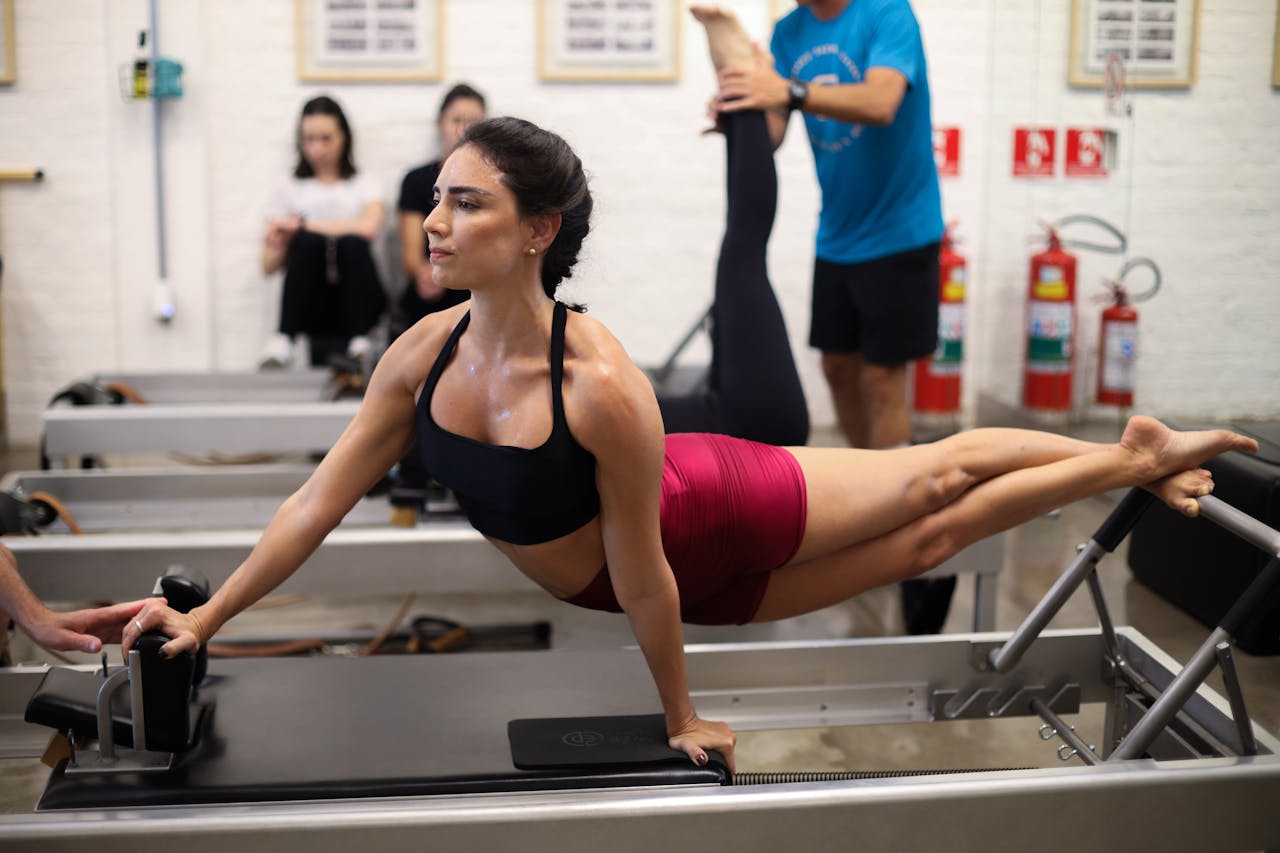
Table of Contents
What is Pilates? A focused strengthening and toning exercise with numerous benefits. Using Pilates will help improve both mental and physical health.
Key Takeaways
- Definition: Pilates is a low-impact exercise developed by Joseph Pilates in the 1920s, focusing on core strength, flexibility, and overall fitness.
- Pilates Principles: Includes centering, concentration, control, precision, breath, and flow.
- Benefits: Enhances core strength, improves posture, increases flexibility, promotes mental well-being, and serves as physical therapy.
- Types: Includes mat Pilates, Reformer Pilates, and specialized forms like Clinical Pilates.
- Equipment: Utilizes various equipment such as reformers, Cadillacs, chairs, barrels, magic circles, and mats.
- Pilates Training Programs: Designed by Pilates instructors, these programs emphasize practicing Pilates for comprehensive health benefits.
- Defining Pilates Exercise Programs: These programs focus on practicing Pilates to improve fitness and rehabilitation.
What Is Pilates
Pilates is a form of low-impact exercise developed in the 1920s by Joseph Pilates. It was originally used in an exercise rehabilitation setting but is now often used as an exercise program to help with postural alignment, increase an individual's fitness level, and other health benefits.
The Pilates method revolves around maximizing core strength with precise and controlled movements utilizing the entire body while, at the same time, matching breathing to bodywork. It has many physical and mental health benefits and helps improve general fitness.
6 Pilates Principles
The Pilates exercise program is more than just a form of exercise; it's a disciplined practice grounded in a set of guiding principles that Joseph Pilates, the founder of the method, considered essential. These principles are not just exercise techniques but are meant to be integrated into performing Pilates movements, ensuring effectiveness and safety. Here are the six fundamental principles of Pilates:
- Centering: This principle focuses on physically bringing the focus to the center of the body, the powerhouse area encompassing the abdomen, lower back, hips, and buttocks.
- Concentration: Pilates demands intense focus and concentration on your body's movements, aligning body and mind to execute each exercise effectively.
- Control: Every Pilates exercise is performed with complete muscular control, avoiding sloppy, uncontrolled movements.
- Precision: Emphasis is placed on precise and perfect movement, with each exercise having a prescribed placement, rhythm, and breathing pattern.
- Breath: Pilates incorporates specific breathing techniques to ensure effective oxygen flow and assist in movements' fluidity and precision.
- Flow: This principle is about the fluidity of movement in Pilates. Exercises are performed flowingly, aiming for grace and ease in movement transitions.
Benefits of Pilates
Pilates workout offers a range of benefits that contribute to both physical and mental well-being:
- Enhanced Core Strength: Strengthens and tones the core muscles of the abdomen, lower back, hips, and pelvis.
- Improved Posture: Helps develop better posture by strengthening the postural muscles and aligning the spine.
- Increased Flexibility: Pilates exercises stretch muscles and joints, improving overall flexibility.
- Mind-Body Connection: Encourages mindfulness and body awareness, which can enhance mental clarity and reduce stress.
- Injury Prevention: By improving muscle balance and posture, Pilates helps reduce the risk of injuries, especially those related to muscular imbalances.
- Better Balance and Coordination: Pilates enhances balance and coordination by focusing on precise and controlled movements.
Types of Pilates
The Pilates training program, a versatile form of exercise, is available in various styles, each catering to different needs and preferences.
The most widely recognized type is mat Pilates, performed on the floor using a mat. It's the most accessible form, focusing on using body weight for resistance and is ideal for those who prefer a simple yet effective workout.
Reformer Pilates, another popular type, utilizes the Pilates reformer machine, a sophisticated apparatus that uses springs and pulleys to provide resistance. This form is more intense and allows for a broader range of exercises than Mat Pilates.
Specialized forms like Clinical Pilates are also tailored for rehabilitation and are often used in therapeutic settings to address specific injuries and conditions.
Contemporary Pilates is another variation that integrates modern knowledge of exercise science, offering a more updated approach to the traditional Pilates method.
For those adhering to the original teachings of Joseph Pilates, Classical Pilates is the go-to, emphasizing a strict sequence of exercises performed in a specific rhythm.
Other types include:
- Stott Pilates
- Winsor Pilates
- Fletcher Pilates
Each type of Pilates offers distinct benefits and experiences, making it important for individuals to choose the one that best aligns with their fitness goals and personal preferences.
Pilates Equipment
Pilates classes use various equipment to enhance training and provide a diverse workout experience. Here's a look at some key Pilates apparatuses you might come across in Pilates studios:
- Pilates Reformer: The most well-known Pilates equipment, the reformer, is a bed-like frame with a flat platform (carriage) that rolls back and forth on wheels within the frame. It uses springs for resistance, ropes, and pulleys, providing a dynamic and varied workout.
- Pilates Cadillac or Trapeze Table: This large piece of equipment resembles a four-poster bed with a canopy. Equipped with springs, straps, bars, and trapezes, it is used for a wide range of exercises, offering support and resistance.
- Pilates Chair: A smaller piece of equipment, the Pilates Chair has a seat and pedals with springs that can be adjusted for resistance. It's used for sitting and standing exercises, particularly for leg and abdominal muscles.
- Pilates Barrel: Including the Ladder Barrel, Spine Corrector, and Arc Barrel, these curved wooden or metal structures are designed to assist spinal articulation and stretching exercises.
- Magic Circle: Also known as the Pilates Ring, this flexible ring provides mild resistance and is used for upper and lower body exercises, particularly effective for inner and outer thigh toning.
- Pilates Mat: While not a machine, the Pilates mat is fundamental for floor exercises. Thicker than a standard yoga mat, it provides cushioning and support for various mat exercises.
Each piece of Pilates equipment is designed to target specific muscle groups and enhance the effectiveness of the exercises. This variety allows for various exercises, making Pilates adaptable to different fitness levels and goals.
How to Get Started with Pilates
Getting started with Pilates workouts is an exciting step towards improving your mental and physical health. The first thing to consider is finding a certified Pilates instructor.
This is crucial because a qualified Pilates instructor will ensure you learn the correct techniques from the beginning, reducing the risk of injury and maximizing the benefits of your workouts.
When you're new to Pilates, starting at a pace that feels comfortable for you is important. Remember, Pilates practice is not just about physical fitness; it's also about developing a deeper connection between your mind and body.
This holistic approach makes Pilates so beneficial for mental and physical health. As you progress, you'll notice improvements in your physical strength and flexibility, focus, stress levels, and overall well-being.
Finally, be patient with yourself. Like any new skill, mastering the Pilates technique takes time. Enjoy the process, listen to your body, and trust your instructor's guidance. With regular practice, you'll soon start to experience the many benefits Pilates offers.
Frequently Asked Questions
Is Pilates for everyone — young and old, beginner and professional?
Yes! Pilates is for seniors, expecting mothers or those who have just given birth, athletes, teens, or beginners.
Anyone who wants to try it for the first time can and should do it. Pilates offers fabulous training in core strength, balance, and flexibility while improving mind-body balance.
For those who need clarification on the difference between Pilates and yoga practices, our blog post on Pilates vs. yoga covers both aspects.
Can I lose weight doing Pilates?
Yes, Pilates can help with weight loss. While most people use other cardio workouts such as swimming, running, or biking for weight loss, they are the better option because they provide more toning and balanced fitness while simultaneously being aerobic.
If you are considering Pilates for weight loss, we’d recommend investing in a Pilates reformer. Merrithew makes several high-quality options, including STOTT reformers or any other type of equipment.
How often should I do Pilates?
The more someone practices Pilates, the better they will get at it. Of course, this does not mean an individual should go to the studio daily.
For those asking, “Where can I find a Pilates studio near me?” and finding it hard to find a studio nearby, many online Pilates class options are available for home practice.
Is Pilates a Good Cardio Workout?
It is not considered a traditional form of cardio like running, swimming, or biking. Instead, it focuses more on strengthening and toning.
Still, it can be incorporated for those looking for a great at-home cardio workout. It is also an excellent tool for rehabilitation when an individual has an injury.
References
Does a Program of Pilates Improve Chronic Non-Specific Low Back Pain? in
Defining Pilates exercise: A systematic review - ScienceDirect
Pilates: What Is It? Should It Be Used in Rehabilitation? - Christine E. Di Lorenzo, 2011
Pilates: how does it work and who needs it? - PMC
Introduction to Pilates-Based Rehabilitation
The Pilates method: history and philosophy - Journal of Bodywork and Movement Therapies
Effects of Pilates Training on Lumbo-Pelvic Stability and Flexibility - PMC
Is Pilates as Good as Everyone Says? - The New York Times
Disclaimer
The contents of this article are provided for informational purposes only and are not intended to substitute for professional medical advice, diagnosis, or treatment. It is always recommended to consult with a qualified healthcare provider before making any health-related changes or if you have any questions or concerns about your health. Anahana is not liable for any errors, omissions, or consequences that may occur from using the information provided.

By: Anahana
The Anahana team of researchers, writers, topic experts, and computer scientists come together worldwide to create educational and practical wellbeing articles, courses, and technology. Experienced professionals in mental and physical health, meditation, yoga, pilates, and many other fields collaborate to make complex topics easy to understand.
